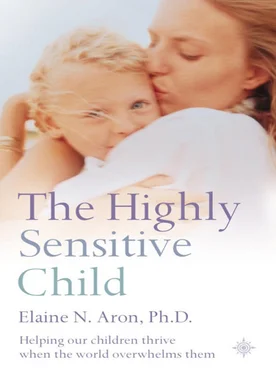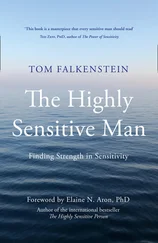Some HSCs throw tantrums and have rages to avoid what irritates or overwhelms them or as a reaction to it. Others try to cause no trouble, to be perfectly obedient, hoping no one will notice them or expect more of them. Some stay glued to the computer or read all day, mastering a smaller world. Others will begin to overcompensate for what seems to them to be a flaw, by striving to be stars or perfect.
Some overstimulated HSCs bounce off the walls and seem to have attention deficit disorder, ADD (but their attention is fine when they are not overstimulated and have their priorities straight—more about that later). Or they have “meltdowns,” lying on the floor and screaming. Others become very still and quiet when overstimulated. Some develop stomachaches or headaches—their body’s reaction and also its solution if that means they can go and rest.
Finally, as we will see, some HSCs feel they have tried everything and finally give up. They become afraid and withdrawn and lose hope.
Children can exhibit any of these behaviors for other reasons, and all children can become overstimulated without being HSCs. But too often sensitivity is the last explanation adults think of when children rage, are depressed, bounce off the walls, have stomachaches, or become stressed-out overachievers. It is my hope that, with the publication of this book, people will no longer overlook that possibility. At the end of the chapter I will discuss how to distinguish an overaroused HSC from children who are not sensitive and children with more serious problems.
If There Are So Many HSCs, Why Haven’t I Heard of This Before?
Today, we know that about 50 percent of personality is caused by innate temperament differences such as high sensitivity. The other 50 percent is caused by experiences or the “environment.” But not so long ago psychologists believed that a person’s personality was completely determined by experiences, especially experiences within the family.
When psychologists did begin to study temperament, it was easy to describe the actions and feelings of active children as they were observed in the laboratory or at school, but harder to describe those who stood in the back of the room or were quiet. You might say that this difference of doing less was the easiest to observe—all cultures observe this difference in people—but the hardest to describe. So observers tended to assume that the quiet ones were shy, afraid, unsocial, or inhibited. In identifying the trait of high sensitivity, we have simply gained a more accurate label.
I see no evidence that children are born afraid, timid, shy (afraid of social judgments), negative, or preferring to avoid human contact. Such innate fear would be a terrible flaw in a social species such as ours. It would not have withstood the tests of evolution and been passed on over generations, as this trait clearly has been. All of these reactions or characteristics, if they arise, can be better understood as a vulnerability due to something more basic, sensitivity. (Or in some shy, fearful, inhibited nonsensitive people, these reactions are purely due to bad experiences, but not genetics.)
What we call this trait does matter. Labels tell us what we are dealing with as well as affect how children are viewed and view themselves. Naturally, those in the majority, the nonsensitive, have developed assumptions about what is going on inside sensitive children. Sometimes they may be projecting a bit—seeing in the “other” what they do not like and want to be rid of in themselves (perhaps fear or what they see as “softness” or “weakness”). But from the inside, sensitive children and their parents know the rest of the story—these children are sensitive .
IS YOUR CHILD HIGHLY SENSITIVE?
If you have not already done so, fill out the questionnaire at the end of the Introduction. Every “true” is a statement about an HSC. These questions are the result of research involving thousands of children. However, not all the statements will be true of every HSC. Children, like adults, vary enormously, in both their other inherited traits and the environment in which they grow up. So another way to decide is to do what you are doing—reading this chapter—and then seeing if it seems to fit your child.
Parents often know right away that they have an unusually sensitive child. Any newborn can be fussy or colicky, but sensitive infants cry mainly when there’s too much (for them) happening around them for too long. And for a sensitive infant, it takes much less to be “too much.” Sensitive children are also more affected by the moods of their parents—for example, anxiety. You can imagine the vicious circle that can create—you will find more on this topic in Chapter 6.
On the other hand, some sensitive babies don’t cry very much at all. Their parents have caught on to their infant’s sensitivity, perhaps because they are sensitive themselves, and have kept their child’s world calm and not too stimulating. Yet sensitive infants are still noticeable—they seem to follow everything with their eyes, respond to every sound or change in tone, and react to the fabrics against their skin or the temperature of their bathwater. As they grow, HSCs notice even more—that you are wearing a new shirt, that the broccoli has some spaghetti sauce on it, that there aren’t any trees growing here, that Grandma moved the sofa. And again, they are even more easily overwhelmed as they grow because they are experiencing so much more and have not yet become familiar with what they see, or learned how to reduce what their senses are absorbing.
So Why Is My Child Sensitive but Others Aren’t?
Any temperament trait is an innate, and thus very basic, aspect of a person’s behavior. It is genetically determined and usually present from birth. The basic temperament traits are found not only in humans but in all higher animals. Think of the temperaments typical in different breeds of dogs—the friendly Lab, the aggressive pit bull, the protective sheep dog, the proud prancing poodle. How they are raised matters, too, of course, but you cannot make a bulldog act like a Chihuahua. These personalities evolved, or were developed by breeders, because they are highly adaptive in certain situations. Therefore they are not disorders or impairments. All of them are normal dogs.
Biologists used to think that evolution guided every species toward a perfectly adapted prototype for living in a particular ecological niche. There is a design for an elephant that will work perfectly—a perfect length of trunk, height, thickness of skin. Elephants born with these features will survive while those that do not will die out.
Yet it turns out that in most or perhaps all animal species we find two “personalities.” A sizable minority are like your child—more sensitive, aware of subtleties, checking everything before proceeding—while the majority go boldly ahead without paying close attention to the situation or their surroundings.
Why would this difference exist? Imagine two deer at the edge of a meadow with grass that looks especially nutritious. One deer will pause a long time to be certain no predators are lurking. The other will pause briefly, then rush out and eat the grass. If the first deer was right, the second deer is dead. If the second deer is right, the first deer misses out on the best grass and, if this happens often, may suffer from malnutrition, become diseased, and die. So having two strategies, two “breeds” of deer in a herd, increases the odds of that group of deer surviving no matter what happens in the meadow that day.
Interestingly, even a study of fruit flies found this difference—and the gene that causes it. Some fruit flies have a place on their “forage” gene that makes them “sitters”—they do not forage far when food is present. Others are called “rovers” and do forage afar. Even more interesting, the gene causes the sitters to have the more sensitive, highly developed nervous systems!
Читать дальше











